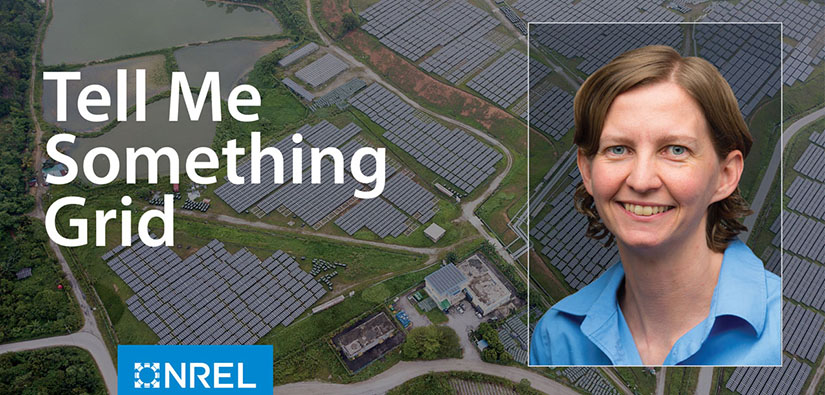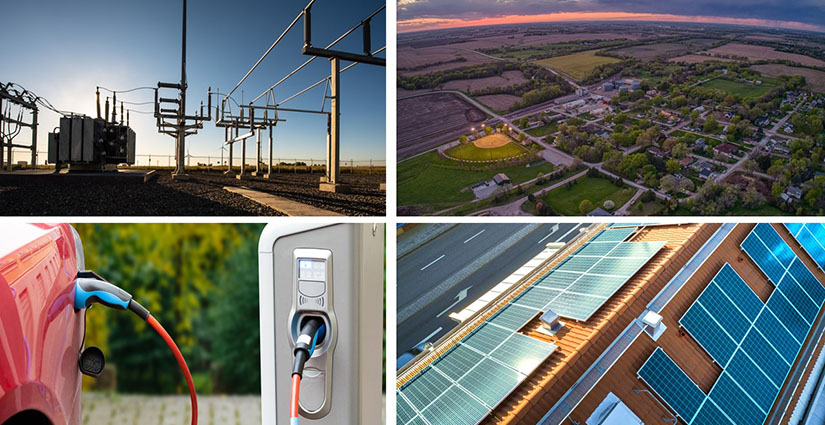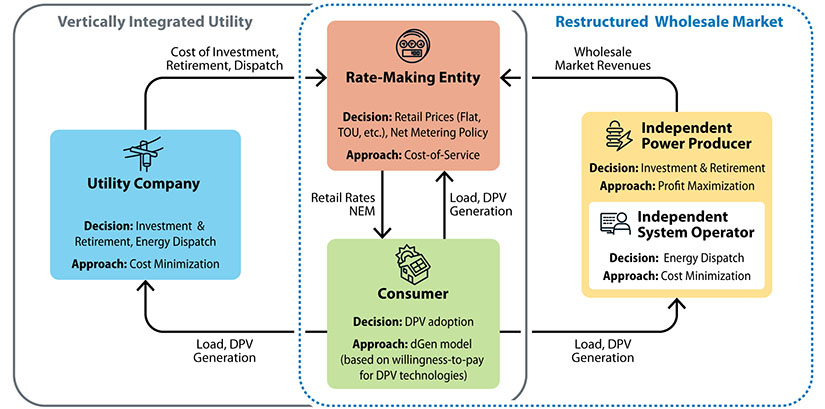New Modeling Approach Ensures All Community Members Are Considered in Electricity System Evolution
NREL Grid Analyst Elaine Hale Describes How NREL Is Analyzing Multiple Stakeholder Perspectives Using an Integrated Modeling Approach

Elaine Hale is a part of the Grid Planning and Analysis Center at the National Renewable Energy Laboratory (NREL). In this installment of NREL's Tell Me Something Grid series, she discusses the importance of integrated modeling and analysis that capture the characteristics and behavior of multistakeholder systems.
Historically, the evolution of the electricity system has been modeled from the perspective of a single utility or central planner, with limited consideration of the diversity of individual consumers and suppliers and societal objectives, incentives, and actions. But that approach is becoming less effective.
There are now diverse electricity systems throughout the world, with many stakeholders who have different and sometimes conflicting goals and new technologies of various sizes and with diverse characteristics. With so much change happening, we need new modeling approaches that consider the perspectives and goals of diverse electricity consumers and suppliers as well as the broader society.
At NREL, I have been working with my colleagues and fellow grid analysts Nongchao Guo, Jenny Sumner, Jessica Lau, Mark O'Malley, Bryan Palmintier, and Shanti Pless to develop a new integrated modeling approach that encompasses multiple stakeholder perspectives. We recognize that aligning stakeholder needs could be perceived as slowing down the energy transition, but it is important to appreciate every stakeholder's unique role in the electricity system to improve the odds of a successful, sustainable energy transition.
Why Electricity Systems Are Becoming More Diverse
Recent and ongoing technological, market, and policy innovations are diversifying the landscape of electricity systems. For example, in the United States, more than two-thirds of the electricity load is served within regions operated by restructured wholesale markets. Utilities can also be vertically integrated, meaning they own and operate generation, transmission, and distribution assets, distribution only, energy only, or bundled energy and distribution. Utility ownership also varies. Utilities can be investor owned, publicly owned, or cooperatively owned.
State, regional, and local policies are an additional source of electricity system variability and complexity. For example, many state governments have established renewable portfolio standards to reduce carbon emissions from the power sector, but policies vary greatly from one state to another.
At the same time, there is increasing adoption of distributed energy resources (DERs), such as solar photovoltaics (PV) and battery storage, as well as demand response participation. New, potentially schedulable loads, such as electric vehicle charging, are also creating opportunities for more active demand-side participation. As a result, jurisdictions are taking a closer look at the affordability of electricity and if DER programs can be designed to provide more benefits across communities.
Overall, technological, policy, and physical environments are changing due to these many factors, and more stakeholders want to be included in conversations about the future of electricity systems.
Holistic Electricity Model Brings Together Existing Data and Methodologies for a More Complete Picture

Most capacity expansion models, such as NREL's Regional Energy Deployment System (ReEDS™) model, consider the perspective of a single stakeholder or central planner and determine an optimal resource mix by minimizing the total investment and operational costs while adhering to policy and reliability targets.
DER adoption generally is not represented in capacity expansion models but through agent-based models, such as NREL's Distributed Generation Market Demand (dGen™) model. These models are trained on real data to simulate the behavior of individual "agents" or people within a studied area. Agent-based models have the ability to understand large trends that emerge from individual customer behaviors. They can also evaluate the impacts of rate structures and net metering policies.
Models like ReEDS and dGen are great at what they do, but they mostly operate independently and don't consider many stakeholders. For example, DER adoption models generally do not capture interactions with investment in and retirement of power system generation, storage, and transmission; and capacity expansion models generally do not analyze stakeholder interactions and decisions across different regulatory structures.
We have been working hard at NREL to develop an integrated methodology for capturing the characteristics and behavior of multistakeholder systems with diverse objectives in our Holistic Electricity Model (HEM). HEM integrates data and methods from models like ReEDS and dGen and pulls in additional information on other power system features, such as voluntary green power markets and distribution system costs—and it uses a decentralized, stakeholder-centric approach with multiple perspectives to ensure that all members of an electricity system are considered as the structure evolves.
HEM answers new emerging questions, such as what are the specific drivers that encourage decentralized generation, and how do they balance with drivers that favor centralization? And to what degree might customers or communities choose total or partial self-supply?
HEM is also highly flexible and can account for an arbitrary number of stakeholder perspectives, each with configurable outcome metrics, constraints, and decision-making processes. The model's structural flexibility reflects the complex dynamics of stakeholders instead of shoehorning their dynamics into a prespecified mathematical form. We like to think of HEM as pulling back the curtain to allow more electricity system participants to engage in the conversation about how to ensure clean, affordable, and reliable electricity.
Distributed Photovoltaics Case Study
To illustrate how the HEM framework can be used, we conducted a case study of distributed PV adoption in a bulk power system comprising natural gas and utility-scale PV generators. We looked at utility-scale investment, retirement, and dispatch; customer distributed PV adoption; and retail rate-making across eight scenarios with different regulatory structures and other policies.
Existing capacity and technology cost data for both existing and new centralized generation resources came from ReEDS and NREL's Annual Technology Baseline. Load profiles for each consumer sector came from dGen, and load profiles for the industrial sector came from data developed with the Demand-Side Grid Toolkit for NREL's Electrification Futures Study. HEM then modeled the decision-making processes and constraints of five key stakeholders: the utility company, the rate-making entity, the consumer, the independent power producer, and the independent system operator.

Results show that the HEM modeling approach transparently illustrates trade-offs that are being discussed among electricity system stakeholders: trade-offs between supplier and consumer surplus, repercussions of net energy metering, and how time-of-use rates and distributed PV can be mutually supportive.
Although the case study is only a proof-of-concept, we are excited about the results and that HEM demonstrates the ability to quantify the relative impacts of different power system features and perspectives. It is difficult for any single modeling tool to provide a complete picture of the holistic, societal trade-offs in electricity systems, but HEM offers unprecedented flexibility to explore trade-offs for local and regional electricity systems. The model is straightforward to formulate and can easily add more stakeholders as well as additional metrics that are important to individual stakeholders or society as a whole.
Learn more about the Holistic Electricity Model in an IEEE Transactions on Energy Markets, Policy, and Regulationarticle. Read more from NREL's Tell Me Something Grid series, and sign up for NREL's energy analysis newsletter.
This article has been updated to reflect an editorial change made after its original publication.
Last Updated May 28, 2025
